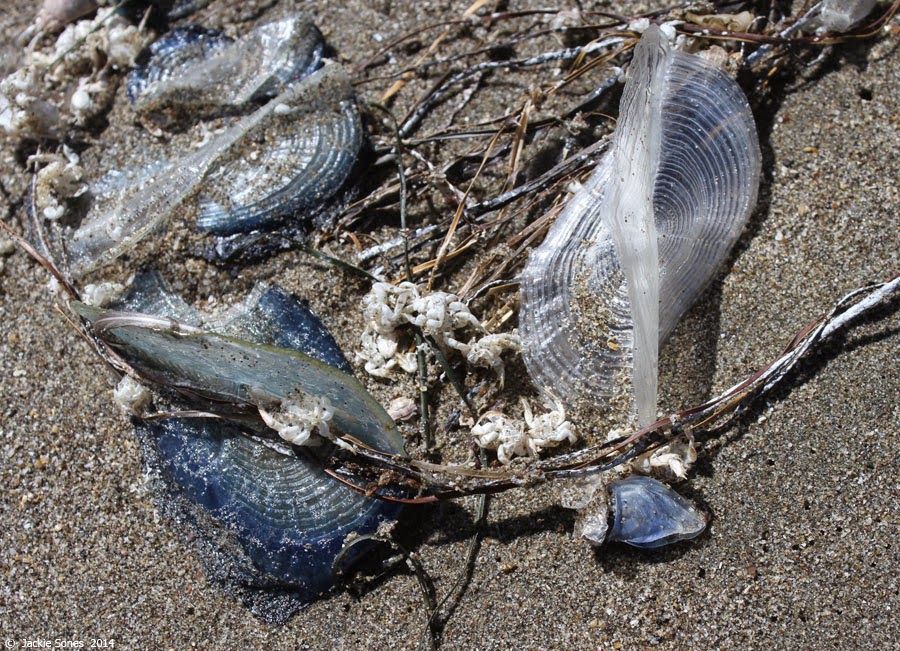On 30 August, Eric and I had a busy day of moving and errands, but in the afternoon we made time for a quick walk on Salmon Creek Beach. We were seeing some By-the-wind Sailors (Velella velella) and salps (Thalia democratica), and we came across one small Ocean Sunfish (Mola mola), but nothing too unexpected. Just as we were about to turn around, I looked down to see something like this:
There are some By-the-wind Sailors and some Mole Crab molts, but did you spot the bright blue barnacle in the lower right corner? Wow! Neither Eric nor I had seen a barnacle like that before! (For scale, the barnacle was ~2 cm long.)
Were there others? We started looking, and found a few more:
And yes, the barnacle in the photo above is attached to the float of the By-the-wind Sailor. Some of the blue barnacles we found were attached to By-the-wind Sailors, while others had a mysterious material at the end of the stalk.
Since we'd never encountered this species of barnacle before, we brought a few back for identification and documentation. Some of the barnacles were still alive, so I placed them in a small aquarium for photos.
The barnacle in the image below has some of that "mystery material" at the end of its stalk (or peduncle). Note that it's very buoyant!
Sometimes more than one barnacle was attached to one float (see below). The next photo also highlights the barnacle's plates. In this species, the plates aren't very calcified, so they're almost transparent.
We were excited to identify this as a Blue Buoy Barnacle (Dosima fascicularis, formerly Lepas fascicularis). We often encounter other species of pelagic barnacles (e.g., see post from 11 August), but this open ocean species is known for an unusual capability. Although initially the larva attaches to a floating object (such as a feather, driftwood, algae, or By-the-wind Sailor), the barnacle then produces a float of its own!
In the next illustration, the barnacle started out growing on a feather, but then secreted a foam-like float made of bubbles (it's thought that the bubbles are filled with carbon dioxide).
Modified from Boetius, J. 1952-1953. Some notes on the relation to the substratum of Lepas anatifera L. and Lepas fascicularis E. et S. Oikos 4: 112-117.
So the "mystery material" we observed attached to the end of the barnacle was actually a float secreted by the cement glands in the barnacle's stalk. Those floats are visible in the aquarium photos above, and here's a close-up taken under a microscope. You can see the bubbles!
Along with this remarkable float, the other striking characteristic of these barnacles was their intense blue color. Here are two views of the cirri, or thoracic appendages, that the barnacle uses to feed.
The blue color is apparently derived from their food (e.g., copepods).
I'm afraid I don't know how often Blue Buoy Barnacles appear on Northern California beaches. This is the first time we've seen them during the past 10 years. Most of the barnacles we saw were attached to By-the-wind Sailors, so it's possible their occurrence could be related to significant strandings of Velella velella (as we've had this summer). I'm also wondering if the barnacles are more often associated with warmer water?
It's amazing to think about these bright blue barnacles drifting along in the open ocean hanging down from their self-made buoys!

















































